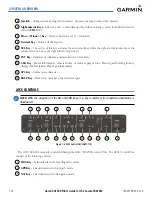
Garmin G1000 Pilot’s Guide for the Socata TBM 850
190-00709-00 Rev. A
1-16
SYSTEM OVERVIEW
1.6 SYSTEM OPERATION
The displays are connected together via a single Ethernet bus, thus allowing for high-speed communication.
As shown in Figure 1-1, each GIA 63W is connected to the on-side PFD. This section discusses the normal and
reversionary modes of operation as well as the various AHRS modes of the G1000 system.
NORMAL OPERATION
PFD
In normal mode, the PFD presents graphical flight instrumentation (attitude, heading, airspeed, altitude
and vertical speed), thereby replacing the traditional flight instrument cluster. The PFD also offers control for
COM and NAV frequency selection.
MFD
In normal mode, the right portion of the MFD displays a full-color moving map with navigation information,
while the left portion of the MFD is dedicated to the Engine Indication and Crew Alerting System (EICAS).
Figure 1-9 gives an example of the G1000 displays in normal mode.
Figure 1-9 Normal Operation
MFD
PFD1
PFD2
REVERSIONARY MODE
NOTE:
The G1000 system alerts the pilot when backup paths are utilized by the LRUs. Refer to the Appendices
for further information regarding system-specific alerts.
Reversionary mode is a mode of operation in which all important flight information is presented identically
on at least one of the remaining displays (see Figure 1-10). Transition to reversionary mode should be
straightforward for the pilot, for flight parameters are presented in the same format as in normal mode.




































